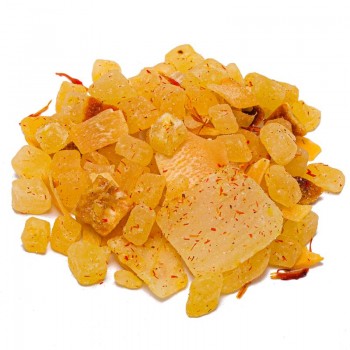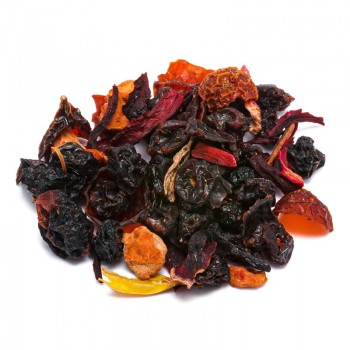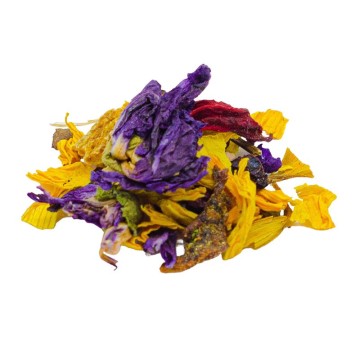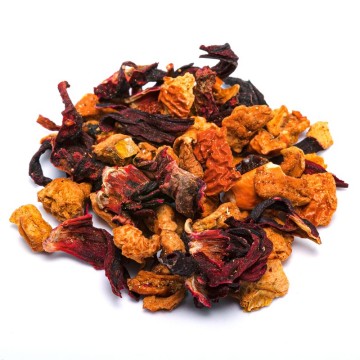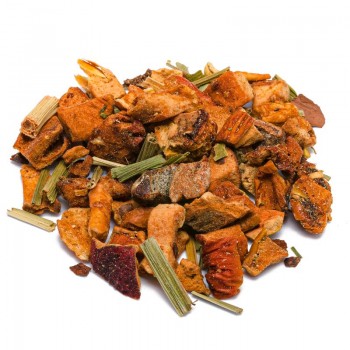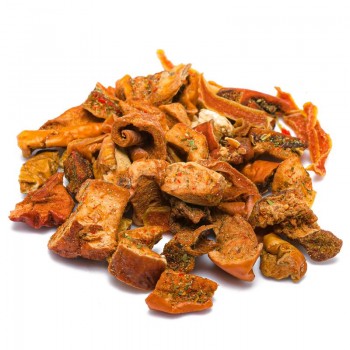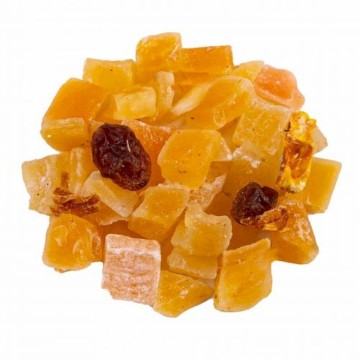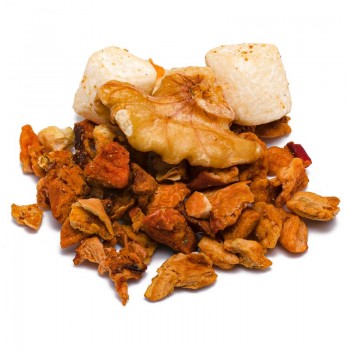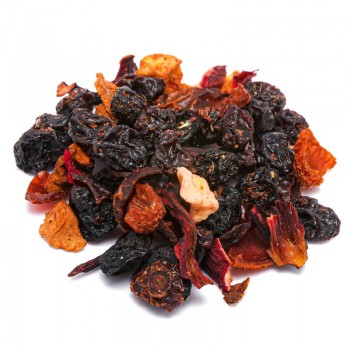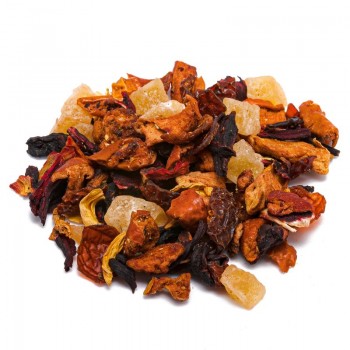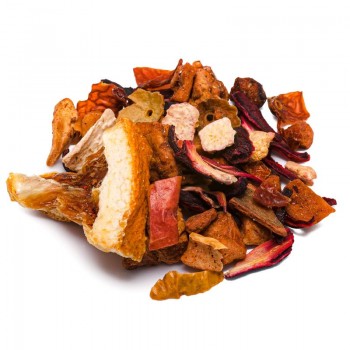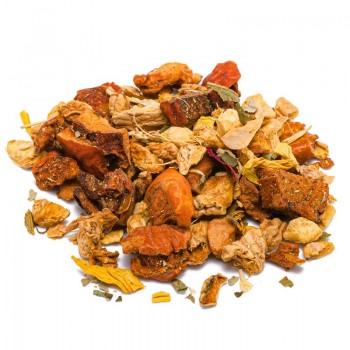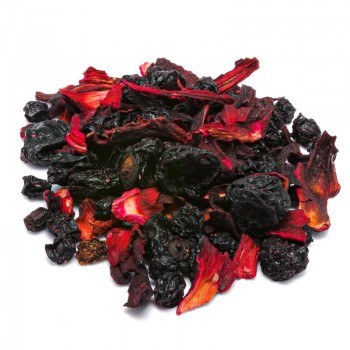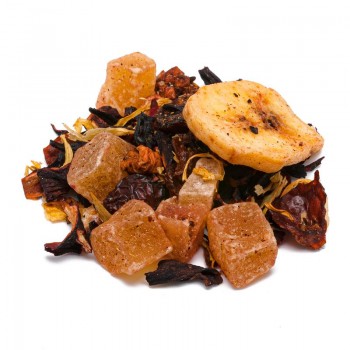The spicy and intense aromas of this drink are noted for the presence of black pepper (piperine), pink pepper, and ingredients from warm and intense flavour, in addition to spicy ginger. Cardamom, turmeric, cinnamon and cloves envelop the sense of smell with a pungent and stimulating fragrance, which combines with the matè base for a boost of energy.
This infusion gives flavors and benefits to every sip, and should be prepared in the morning as an energizer. Even after lunch, to regain energy and digest food as best as possible, avoiding incorrect assimilation. It is advisable not to take this infusion in the evening, because its energizing and stimulating substances could interfere with sleep.
Piperine, turmeric and mate infusion: properties and benefits
A powerful drink, it combines the energy of Yerba Mate with spices. The blend is rich in natural energy, which can awaken your body and mind at the start of the day. Yerba mate is a drink known in South America, obtained from the infusion of the leaves of a local evergreen plant. Drinking mate is a real ritual, and is beneficial due to the high concentration of caffeine content. The mate base (also called matè) therefore gives an energetic power to the infusion as well as providing various amino acids. Mate stimulates the nervous system through its active ingredients, which is why it is often considered a substitute for coffee - capable of providing concentration and acting as a tonic in case of physical and mental tiredness.
The infusion uses maté to also promote diuresis, thanks to the organic compounds that help drain excess body fluids, against water retention. It represents an aid in maintaining body weight balance, because it acts on lipid metabolism and gives a sense of satiety. The infusion, thanks to the mate and other elements, performs a thermogenesis function, in which the heat helps burn fat by stimulating the metabolism. Support is given by piperine - the main alkaloid of black pepper - and turmeric.
The fusion of spices makes beneficial principles available, such as the curcumin contained in turmeric. Usually turmeric and black pepper combine to enhance the absorption of curcumin and increase the active ingredients of both. The combination of mate with other spices also promotes digestion, stimulating the secretion of gastric acids and facilitating the absorption of nutrients at the gastric and intestinal level. Both piperine, ginger and cinnamon stimulate acids useful for the digestive process. Turmeric also helps a smooth intestinal transit, acting as a purifying and draining function like matè. All the stimulating and tasty exotic spices as elements of the infusion have been used in herbal medicine for centuries, particularly in Indian Ayurvedic drinks.
Origins and history of cultivation
Yerba mate or matè is a traditional Latin American drink. It is obtained by infusing the dried leaves of the yerba mate plant, Ilex paraguariensis, in hot water.
It can be served cold or hot, usually in a characteristic container, called mate, made of wood or steel. The yerba mate leaves and hot, not boiling, water come together in the container and are consumed with a particular straw called bombilla, equipped with a filter. Filtering is necessary to suck up only the liquid leaving the leaves in the container. The ritual requires that mate is offered to everyone, adding hot water every now and then, according to an ancient tradition of the Guaraní drink (populations that live mainly in Paraguay, Brazil and Argentina). The ritual has recently also arrived in European countries and the rest of the world, where the filters allow rapid preparation of the matè. Turmeric is a spice of Asian origins that shows an intense yellow color, similar to saffron.
It is native to southern India and Indonesia, and is also widely cultivated on the islands of the Indian Ocean. Its beneficial properties are due to curcumin, the active ingredient extracted from the rhizome, a sort of root found underground. For this reason it has been used since ancient times as a spice and condiment, as well as a dye for fabrics. Its aroma is similar to that of pepper, with a warm and bitter flavor highly appreciated as a digestive stimulant in oriental medicine. Piperine is an organic compound that derives from black pepper, and is an element that gives the spice its pungent flavor. As a compound it is classified in the family of alkaloids or lipids (fats and similar substancesili to fats). Alkaloids are nitrogenous compounds with strong physiological properties.
It is present in black pepper at approximately 5-9%, and was isolated chemically for the first time in 1820 and its chemical constitution studied with laboratory synthesis in 1882. The black pepper plant, from which it derives, it is native to the Malabar coast of India and is one of the first spices known historically.
Spices and other ingredients
Curcuma longa is a herbaceous plant of the ginger family (Zingiberaceae). Turmeric plants reach about 1 meter in height, with long leaves and yellow-orange flowers. The rhizome or root of organic turmeric is known for the presence of curcumin, one of the curcuminoids that make up this part of the plant. The rhizome is found under the surface of the soil, just underground, and is branched.
There are different varieties of the plant, but the most widespread is Curcuma Longa, also known as Curcuma Domestica.
Black pepper is Piper nigrum is a climbing plant of the Piperaceae family, from whose fruits the spicy spice is derived. The plant can reach a height of 10 meters thanks to its aerial roots. Shows glossy green leaves and small clustered flowers. The fruits are drupes, sometimes called peppercorns, they are small and have a strong aromatic smell. They contain a single seed and become yellowish-red when ripe. The flavor comes mainly from piperine.
The yerba mate plant is Ilex paraguariensis, which belongs to the Aquifoliaceae family. The tree requires specific conditions, which is why it is grown correctly only in some small regions of Argentina, Paraguay and Brazil. It takes at least two years between harvests to regrow - it grows up to 8 metres. It shows thick, dark leaves, which are dried to obtain yerba mate or chimarrão. The small white flowers bloom in late autumn, while small red berries appear in late spring.
Ginger is the spice that comes from the rhizome or root of the herbaceous plant Zingiber officinalis. It is a flowering plant belonging to the Zingiberaceae family native to Southeast Asia. It grows for about a meter, developing the underground rhizome, from which the flowers with pale yellow petals arise on the shoots. The rhizome is the one used for consumption and which gives the spice. Ginger can be used fresh, dried, powdered, or in the form of oil or juice. Pink pepper is obtained from the berries of a South American shrub, Schinus Molle. The fruit shows the characteristic pink color and a shape similar to the pepper berry - this is why it is called pink pepper or false pepper. The fruit gives the palate a soft texture and a different flavor from pepper, more delicate and sweet. The cinnamon tree is Cinnamomum zeylanicum (Ceylon cinnamon), an evergreen of the Lauraceae family. Its bark has high aromatic properties, from which cinnamon sticks are obtained. It grows in moist, well-drained soil, and reaches about 15 meters in height. It shows oval leaves and small flowers with yellowish colors, while the fruit is a dark drupe. Among the species similar to the Ceylon plant, others are also cultivated as a source of the spice, including Chinese cassia (Cinnamomum cassia), Vietnamese cinnamon (C. loureiroi), Indonesian cinnamon (C. burmannii), and Malabar (C. citriodorum). Cloves come from the flower buds of the Eugenia caryophyllata (or Syzygium aromaticum) plant. It belongs to the Myrtaceae family and comes from Indonesia. Dried cloves become a spice, and are not related to the clove plant. The cardamom spice comes from the pods of the Elettaria Cardamomum plant, of the Zingiberaceae family. Native to India, the plant develops a pod or capsule that contains several small, dark seeds: once dissolved or ground, they give the aroma of cardamom. There are also varieties such as black (Nepali) cardamom from the Amonum Subulatum plant, brown-brown cardamom and delicate white cardamom.
Nutritional values of piperine, turmeric and mate infusion
The main active ingredients are piperine, curcumin and xanthines - organic compounds present in yerba mate such as theobromine and theophylline. The infusion also makes antioxidant elements. How to use the ingredients in the infusion The infusion is obtained by placing approximately 3-5 grams of the mixture of piperine, turmeric and mate with water at 100 °C in a cup (250 ml). Leave to infuse for 10 to 12 minutes before drinking. Add honey or sugar, sand you want it.
Can piperine, turmeric and mate infusion have side effects and contraindications?
Although it brings benefits, to avoid unwanted effects of the infusion it is necessary to respect the recommended doses and not exceed consumption for too long periods. Excessive intake can cause diarrhea, nausea, stomach pain and gastrointestinal disorders, hemorrhoids, headache and tachycardia. The infusion should preferably be taken during the day, because it could interfere with sleep. It is also advisable to avoid the infusion in case of pathologies of the biliary and hepatic tract, for those suffering from ulcers and gastrointestinal disorders. The combination of piperine and turmeric with maté is not recommended during pregnancy and breastfeeding.

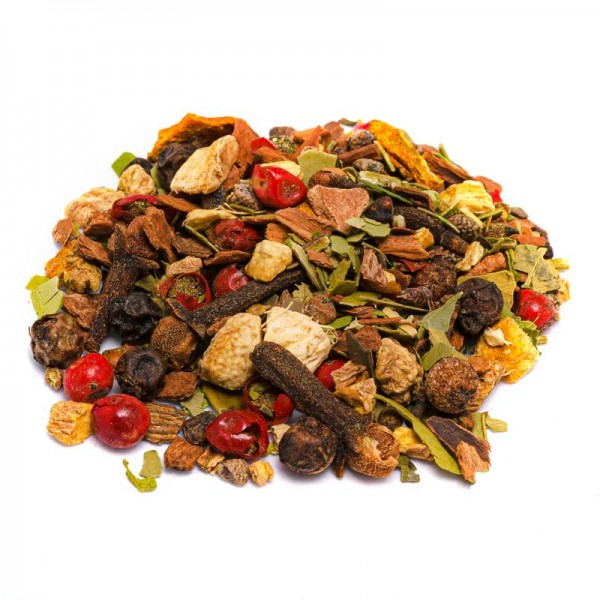









 No reward points for this product.
No reward points for this product.
